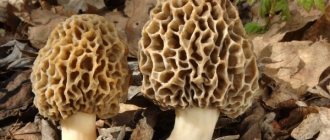Family Membership
Classification, as well as distinctive features, are different for mushrooms. Mycology classifies morels as members of the morel family or Phallus esculentus. The pretentious name, which in translation means similarity to the male organ, speaks of the unusual structure of the mushroom. The hat is cylindrical in shape on a small stem, well camouflaged against the background of rotted foliage. Due to ignorance of the beneficial properties and taste, reminiscent of chicken meat, it often causes jokes and foam from unknowing mushroom pickers. In European countries, it is highly valued and served in restaurants as an ingredient for preparing first and second courses, hot salads and appetizers. It is completely edible and can be compared in taste to champignons and boletus.
Strings are the complete opposite of morels. Unfortunately, mushrooms accumulate life-threatening carcinogens and poisons in their pulp. And although in Russia mycology classifies mushrooms as inedible or conditionally edible, depending on the variety, in Germany the lines are equated with fly agarics and toadstool.
Today you can still meet lovers of quiet hunting, collecting stitches. Unfortunately, they do not think about the dangers of consuming the pulp of a mushroom product after cooking. It has been scientifically proven that even the longest heat treatment is not able to completely remove gyromitrin. The poison persists, regardless of the efforts of the cook. An exception to the rule is species of the Discinaceae family, which are classified as conditionally edible. They can be eaten like mushrooms of the fourth category of edibility. Compared to morels, they do not provide any benefits, bright taste and aroma.
When studying the classification of mushrooms, you need to understand that the information will not be very useful during mushroom hunting. Much more often, the difference between the morel and the line that tells you whether the fruit is edible or not is what saves you. Photos of the differences, clearly demonstrated in the pictures below, help to visually remember the difference, noticeable to the naked eye.
Every year the list of life-threatening mushrooms expands. And although not all lines are still classified as inedible, containing life-threatening elements, collecting unusual mushrooms is not recommended. It is better to hunt for morels, wait for the May row and boletus, than to endanger your health and the lives of your family and friends.
Systematics, characteristics and description of the structure
Edible morel, or real morel (lat. Morchella esculenta) is an edible mushroom belonging to the Morel family.
In the scientific community, morel has several synonyms:
- Phallus esculentus;
- Helvella esculenta;
- Morellus esculentus;
- Morchella rotunda var. esculenta.
The fruiting body is represented by an apothecium, a special type of body that differs from other cap mushrooms.
The cap of the edible morel has a characteristic ovoid, blunt-pointed shape with a large number of folds; in young mushrooms it can be round or flattened-spherical. The color depends greatly on the growing conditions - from yellow-ocher to dark brown. The older the morel, the darker the cap. Dimensions range from 3-7 cm in height and 3-8 cm in diameter. The folds are thin (1–2 mm thick).
The hymenophore - the part of the mushroom that carries the theetium - in morels is located not inside the cap, but outside, lining its bottom and pits.
Reference. The temium is the spore-bearing layer of ascomycetes.
The stalk is hollow inside, the wall thickness is 3–4 mm, the average diameter is 1.5–3 cm. The length of the stalk ranges from 3–9 cm. In young mushrooms it is milky white or creamy white, smooth, darkens as the mushroom ages and is covered with thin flakes.
The cut flesh is the same color as the leg and does not darken. Very brittle, crumbles quickly, especially with old mushrooms. It has no distinct odor after cutting.
A little history
The mushroom was discovered and systematized several times by Carl Linnaeus. The first description under the name Phallus esculentus was made in 1753. The name Morchella esculenta was given later - in 1801 by the Dutch mycologist Christian Person.
Edible or poisonous, a brief history
Morels, despite their awkward appearance and memorable unusual shape, are famous for their captivating nutty aroma and “chicken” taste. Unknowingly, well-cooked mushrooms can easily be confused with tender chicken fillet served with ground nuts.
For many years, morels have been considered one of the best mushroom delicacies. Underrated in Russia, Belarus and Ukraine, they are loved by residents of European countries and CIS territories. Mushrooms are offered on restaurant menus as a separate dish or one of the ingredients used to prepare casseroles, salads and light snacks.
When collecting morels, you don't have to worry about safety. Mushrooms are classified as edible and conditionally edible, depending on the variety. After undergoing heat treatment, the fruits are safe and can be used in cooking. Fried and baked cooking options are more valued than preserved and pickled foods.
Stitches are dangerous mushrooms that easily cause poisoning in the body. Heavy poisons accumulated in the pulp of the fruit are dangerous because their quantity depends on environmental pollution. The closer the mycelium is located to a landfill, cemetery or highway, the higher the percentage of gyromitrin content. Of course, a similar rule applies to most of the family. There are also conditionally edible subspecies that are eaten after repeated heat treatment. However, whether the time spent on processing and preparation for the main preparation is worth it, each mushroom picker decides for himself.
The unusualness of the lines, which distinguishes mushrooms from the entire mushroom world, is the content of an unusual poison - gyromitrin. Its peculiarity is the accumulation effect. The more polluted the germination area is and the less precipitation the hydrometeorological center promises, the more poisons and carcinogens accumulate in the pulp. In many European countries, including Germany, the mushroom is strictly prohibited for consumption, regardless of the variety. The number of reported cases of poisoning leading to intoxication and death is sufficient. In Russia, not all mushroom pickers agree with this characterization of the lines. However, when going out into the forest to look for mushrooms, before filling your basket, you should always weigh the value of life and testing your luck so that you don’t come home empty-handed.
Morels and lines
The first spring mushrooms that arouse the systematic interest of collectors are two groups of “marsupial” mushrooms, united under the names “morels” and “strings”.
It is often believed that “morels are edible, but morels are poisonous,” but this is a serious oversimplification. However, first things first. The first and best spring mushroom, the morel, represents several species of mushrooms from the genus Morchella. The conical morel, Morchella conica, is especially common in our area; other morels are much more difficult to find. However, to find the “konik” you still have to try. In general, spring mushrooms grow differently from “normal” mushrooms. You can idly walk around a very large area, trample down tens of kilometers of barren roads in order to stumble upon a small “mushroom paradise”, stumble upon it and put it on your mushroom map forever.
Looking for morels requires patience and luck; Damaged (but not severely) deciduous systems, edges, ditches, and recent burnt areas may be a clue. I saw the largest amount of conical morels near a construction waste dump in the Istra region; I didn’t find any real morels at all.
Actually, the conical morel is the only mushroom of the morel genus presented on our website. Other morels are similar. They are distinguished from stitches (see below) by the symmetrical-cellular, versus asymmetrical-brain-like, structure of the “hat”. From the “morel cap” (see further below) - the inseparability of the “hat” from the “leg”, an internal unity that paradoxically turns into emptiness.
Another popular group of spring ascomycete mushrooms is called “streak”, or Gyromitra. This genus includes three common species - two spring and one autumn, unpopular and even poisonous. We won’t talk about it, the autumn line (Gyromitra infula). Let's talk about the other two.
The giant string is a really large, sometimes huge mushroom, reminiscent of a brain in a sitting position (in our area, the stem of this mushroom is often absent or too short to discuss seriously; colleagues from Siberia, however, show photographs of giant strings, long-legged, like a morel cap ; mushrooms are a mysterious matter and defy logic). It is considered bad manners to joke when you see a clearing of lines: “someone has lost their minds here.” This has been joked to you more than once.
The giant string grows mainly in deciduous and spruce forests, especially highlighting (in my experience) spruce-birch copses. However, he does not disdain all sorts of atypical places - for example, the wilds of hazel and euonymus along the edges of clearings. You can find it almost anywhere, even in pine trees; not to find, however, much easier. And anywhere too. Although compared to morels, the lines are rootless cosmopolitans.
The ordinary line has a rather tarnished reputation. This line is much smaller than the giant one, less “brainy” and more often has a developed pseudopod. It grows exclusively in pine trees, especially in pine clearings and in young plantings (on the site of the same clearings, presumably); is especially interested in old fires. Unlike the giant string, which is certainly edible, the common string (in Latin called esculenta, that is, “edible”) is considered deadly poisonous in some regions. Here they eat. We eat.
The best minds in the mushroom world tried to explain this phenomenon. They agreed that the presence of the poison gyromitrin in the common line depends on the average annual temperature. There is some threshold below which the poison is not produced; Polish lines are poisonous, and Smolensk ones are already edible.
Convincing explanation? Hardly. However, in the Moscow region we collect and eat ordinary lines. I do this: boil for 15 minutes in a large volume of water, drain the water, rinse the mushrooms with cold water, and simmer in sour cream. Simmer - and listen to how they “shoot” from under the lid, just as Soloukhin once described. He was a great specialist.
The fungus Discina thyroid is also sometimes included in the line; it really grows at the same time, sometimes physically intersecting with both a giant and an ordinary line. They call it “flat stitch”. She is not a relative of the lines, perhaps a distant one. It's good for food, but there's nothing else to eat. I don’t think this mushroom deserves special attention from consumers.
It remains to say about the least known group of spring mushrooms - the so-called “cap”, genus Verpa. The most popular mushroom in this genus is the morel cap. Fruits in a very narrow layer, for a maximum of two weeks; found exclusively in moist young deciduous forests. In a culinary sense, I would say, so-so - so there is no strong motivation to look for tiny pockets of growth of this “cap” in the vast forests. (It is called this because, unlike the morel, Verpa has a clearly defined cap that can be separated from the stem.)
If you happen to drive along the M4 highway through pine forests near the city of Zadonsk (from Voronezh), you couldn’t help but notice the huge stands of pickled mushrooms along the edges of the road. It seems that Zadonsk is the mushroom capital of, if not Russia, then at least the Black Earth Region. Upon first acquaintance, it turns out that the morel cap is a common mushroom in these places, and the locals harvest it (it?) in commercial quantities. Every year.
For fun, you can buy a large jar of pickled cap. I had it open for a very long time.
If we take the aesthetic sense out of the equation, Discina thyroid is a “spread stitch” - it grows in the same place and is just as valued as an ordinary (pine) stitch. Two facts speak against it: firstly, it is many times smaller, and secondly, it often resembles the pellet of a small animal. But appearances are deceptive - the mushroom can be stewed as part of a “line assortment”, no one will notice the substitution.
In warm regions, this line is not only considered, but also poisonous; they are poisoned to death; these, alas, are not legends. They eat and praise us. Strings stewed with butter may seem like the food of the gods - if only the cook manages to completely get rid of the sand that eats into the lower parts of the fruiting bodies.
Probably the best of our lines - also because it usually does not grow on sand and, therefore, does not require such careful processing before cooking. It should be noted that in the numerous cavities of the head part, unresponsive forest inhabitants (insects, snails) may be hiding, which can spoil the appetite of an impressionable eater.
The conical morel, along with the ordinary one (technically, this is generally one species) is called the “spring porcini mushroom.” The cult status of the morel is determined, among other things, by its versatility: it can be fried, dried, even salted and pickled, if you don’t mind. Morel soup, according to successful mushroom pickers, is superior to white soup.
This attractive mushroom, a real decoration of the forest, is often the first edible mushroom - unless you count some strobilurus. This is the main and, perhaps, the only advantage of Sarcoscipha. It is well suited for roasts and does not require pre-boiling; Also suitable as a “mushroom dressing” for soup.
The good thing about the morel cap is that it sometimes appears in huge quantities (not for long, really) and allows you to satisfy your harvesting passion before the high season begins. It is best to marinate it with fragrant spices - the consistency of the caps (the stems must be removed) goes well with the marinade. When fresh or roasted, the cap is not very good - rubbery, without much taste.
Stitches and morels: how they differ + photo differences
When starting to study information about the varieties of mushrooms before harvesting in the spring, you should pay close attention to the differences between morels and strings. A brief description of each variety of mushroom with visual photos will allow you to visually remember the difference, eliminating the collection of poisonous mushrooms instead of an edible product enriched with protein.
In most cases, the distinctive features are shown on a visual table or photo with arrows indicating the difference between families. But we will not repeat the experiment, but on the contrary, we will tell you in more detail about the characteristics of each mushroom, showing pictures and photos as an example.
Short description
Having once seen a mushroom cap in person, even novice mushroom pickers stop wondering what is different and what it looks like. Morels have a cone-shaped upper part that does not hide the stem. Wrinkled structure with small depressions (holes), comparable to dried dried fruit. The lines are even more unusual. Their cap is round in shape with uneven contours. Many compare its structure to a walnut, which is larger than the stem.
In size, the lines are slightly larger than morels. Depending on the variety, the length and volume of the mushroom can exceed edible mushrooms by several centimeters.
In cross section, morels have a uniform structure, colored white or cream. When collected in a bag or basket, they are often deformed and broken into pieces. Collection is recommended exclusively in a bucket or basket. The stitches in the section are not uniform and are fragile when pressed on the flesh.
The most important difference between mushrooms is the stem. When collecting morels, it is clearly visible, thanks to the equal division of the cap and stem into halves. Height - up to 13 cm, but most often does not exceed 10 cm. It is easy to detect mycelium on a damp surface where the snow has recently melted. Most often, fruits germinate in aspens, coniferous substrate or moss. Stitches, on the contrary, have an inconspicuous leg, often hidden under the cap. Despite the same place of germination, when comparing mushrooms with similar names, it is easy to find differences between families if you look closely. For example, the pattern on the mushroom cap is completely different. Edible spring mushrooms have uneven stripes on the cap, like a honeycomb. The stitches are similar to walnut.
Short description
Color varies. Mushrooms, depending on the variety, are colored in a range of brown, gray and yellow shades. However, when comparing mushrooms, one cannot help but notice that the color saturation is more acceptable for stitches. The hats have a bright color scheme, visible to the naked eye against the background of wet leaves that have fallen in the autumn.
Morels give off a mushroom aroma due to their nutty notes. Stitches have a neutral, less often unpleasant, odor. The difference depends on the place of germination and the variety of subspecies. As mentioned above, you should not pick mushrooms based only on appearance and aroma. Even proverbs say that appearances can often be deceiving.
Types of morel mushrooms
The Morel genus has not yet been well studied. There are more than 80 species in this group. This is a complex classification that is constantly changing and does not have clear criteria. All varieties have a similar structure and are considered conditionally edible.
Tall morel
The variety is distinguished by its large size: it reaches 5 - 15 cm in width, 30 cm in height. The fruiting body is dark in color, covered with triangular-shaped cells and narrow vertical folds. Specimens are collected in May, less often in June. The tall species is found on the edges of forests and mountainous areas.
In young specimens, the cells are brown with an olive tint, in mature specimens they are brown, almost black, and the partitions are ocher. The mushroom stem is cylindrical and has a granular texture. Its height reaches 15 cm, diameter - 3 cm. The leg, initially white, gradually becomes yellowish.
Conical morel
In the conical variety, the cap has an elongated shape, its edges grow tightly to the stem. The height is from 6 to 18 cm. The diameter of the cap is from 2 to 8 cm, the height is up to 9 cm. The color of the conical representative is varied, from yellow to brown. Most often they are brown or grayish in color.
The inside of the cap has an empty cavity. On top there are convex folds of a darker color. Externally, the surface resembles cells stretched from top to bottom.
The leg is cylindrical, up to 5 cm high, 3 cm thick. Its inner part is also hollow. The surface of the leg is velvety, covered with grooves. The flesh of the conical type is cream or white. It is thin, fragile, tender, and dries quickly. There is no taste or smell.
Important! Conical morels are quite rare. The fungus grows slowly, this process takes up to two weeks.
Real morel
Edible morel, or real morel, is the most popular variety. Its fruit body is large, fleshy, the inside is hollow. This mushroom reaches a height of 20 cm, while having a small mass.
Representatives of this species have an egg-shaped cap, often round, sometimes flattened. The edges are in close contact with the leg. The height of the cap is up to 7 cm, its girth reaches 3 - 8 cm. There are specimens with yellow, brown and gray colors. Gradually their color darkens. The cap has an uneven surface; it consists of numerous depressions.
The edible leg is hollow, cylindrical-shaped, with voids inside. It breaks easily and has a whitish color. With age, this specimen acquires a yellow or beige color. Its pulp is light, ocher or cream in color, and is easily crushed. The taste is pleasant, there is practically no smell.
Semi-free morel
The mushroom has a pronounced stem and cap. Its average height is 10 cm. Sometimes representatives of this group grow up to 20 cm. Their internal cavities are not filled with anything. The cream stem breaks easily. Its height is from 5 to 12 cm, its girth reaches 3 cm. Its surface is rough to the touch.
The cap reaches 2 - 4 cm in height. Its upper part fuses with the leg, its edges remain free. There are irregular folds on the surface. There are clear ribs that gradually turn black. The color of the cap is brown, light or dark.
Steppe morel
This large mushroom grows up to 25 cm in height. Its weight reaches 2 kg. Prefers open areas: steppes, meadows, clearings. The steppe variety has a gray-brown spherical cap measuring from 2 to 10 cm, the edges of which grow to a cream-colored stem.
The steppe species is developing rapidly. The fruiting body is formed in 7 days. In spring, the steppe variety often grows in groups. If the winter turns out to be little snow, then the mushrooms do not have enough moisture to develop. The dense white pulp is characterized by the absence of voids. Numerous cells are clearly visible on the cap.
stinky morel
The mushroom is also known as Veselka vulgaris. It reaches a height of 10 - 30 cm. Its fruit body is egg-shaped, with a girth of 6 cm. The shell is leathery, smooth, white or cream-colored. Inside there is gelatinous pulp.
As the vesel grows, a spongy cylindrical leg forms. Then a cap up to 5 cm high is formed. Its surface is cellular, mucous, dark olive in color. There is a disc-shaped hole at the top. Mature specimens have an unpleasant rotting odor.
Veselka vulgaris is not used when it reaches full maturity. Within a few hours, the pulp decomposes. Veselka is harvested in the early stages of growth, when it has the shape of an egg or a traditional mushroom.
Attention! The stinking morel has the highest growth vigor in nature. In a minute its dimensions increase by 5 mm.
Varieties of morels: are they poisonous, with photos
Morels are not dangerous. With the ability to distinguish edible and conditionally edible mushrooms from those that have a large percentage of poisonous subspecies, a mushroom picker can collect a whole basket of a delicious product for cooking. The main rule for safety is heat treatment, which removes toxins from the pulp of any mushrooms used as an ingredient in main and secondary dishes.
Common morel
One of the most common varieties. Scientifically, it is the common morel (Morchella esculenta). Due to the fusion of the cap with the stem, the mushroom is often confused and classified as a stitch. A distinctive feature that eliminates any doubt about the relationship of the species is a pattern in the form of “uneven honeycombs”, reminiscent of cells for collecting honey.
Brief description in the photo
- The hat is cone-shaped, uneven in shape.
- The leg is white or milky in color, not exceeding 11 cm in length.
The main disadvantage of the subspecies is the cells on the caps. In wet weather they become home to insects and slugs. To use a pure product for food, you cannot do without soaking. The recommended soaking time in salt water is 1.5 to 2.5 hours. If necessary, change the water several times, replacing the salty version with running water.
Conical morel
Based on the name, it speaks about the structure of the stem and cap. Belongs to the morel family. Myceliums are located only in areas with high humidity. Prey can be found in depressions, moss and wet leaves left after the snow melts. Germination continues until the topsoil is completely dry and there is no rain. The fragility of the pulp does not allow the morel to remain fresh and suitable for harvesting for a long time.
Description of the view in the photo
Common characteristics:
- a hollow cap with a pattern visually similar to volumetric cells;
- the length of the cap, without measuring the stem, reaches 8-9 cm;
- the mushroom is divided into two parts, with the upper one being larger than the lower one in volume;
- the shade of the upper part is brown;
- the leg is hollow, easily deformed when compressed.
Morel tall
Visually reminiscent of the previous subtype - “Conical”. However, it belongs to a separate variety of the morel family. Morchella elata or large morel, is described as a tall or large mushroom. The main difference between two similar morels is color and length. The tall cap is dark brown (red, brown-black) in color, and the length of the fruit as a whole exceeds 30 cm.
Description with photo example
The description of the cap, pattern and stem, by visual inspection, is almost no different from the morel family. You can suspect a predisposition to the tall subspecies only by color and height.
Steppe morel
Grows in the steppe zone. One of the largest morels in size, or Morchella steppicola, is common in Ukraine, Russia and Belarus. Often found before reaching forest-steppe, moss and marshy areas.
Short description
The photo below shows a real example of what the morel variety looks like in the picture. You can go in search of prey no earlier than the beginning of April, completing mushroom picking in mid-May, when spring weather is completely replaced by summer.
Mushroom structure:
- hat - resembles a line hat in shape. Painted in a light brown tint, less often milky;
- the leg is white, in rare cases milky. In cross-section, it is empty and fragile, not exceeding 2-2.2 cm in length.
It is better to go in search of this mushroom with an experienced mushroom picker or a clear photo example, which will not allow you to confuse an edible mushroom with a poisonous one. For beginners who are just learning the ropes of mushroom hunting, it is better to choose another variety of morels for collecting in order to reduce the risks of poisoning.
Morel
What does it look like
It reaches a height of 15 cm, the cap can be round, conical, or ovoid. Color - from light brown to almost black. This variation is explained by the fact that there are several types of morels, but they are all edible and similar to each other. The cap of morels is quite noticeable, it looks a little like skin wrinkled from moisture, cellular. And the leg is white, becoming yellowish with age.
Where is it found?
They grow in forests and prefer bright sunny places. But it can also be found in forest edge thickets, along roads, sometimes even in gardens. Most often they are found under poplars, aspens and alders. Collection time is April-May.
How to cook
Morels are not toxic mushrooms. But since they are often confused with strings that need good heat treatment, it is also recommended to soak morels in cold water for 1-2 hours and then boil them for 20-30 minutes. After this, the mushrooms can be fried. They are very tasty with onions and sour cream.
Lines - poisonous and conditionally edible varieties
Despite concerns regarding the collection of strings, the family includes not only poisonous, but also conditional mushrooms that are acceptable for cooking after prolonged heat treatment. In order not to make mistakes when collecting, it is worth familiarizing yourself with the most common subspecies found in the regions of Russia.
Ordinary stitch
A classic mushroom, one of the most common in Russian cities where there are forest belts of aspen or coniferous trees. Myceliums are often found on sandy soils, where the moist environment lasts longer.
Fruiting lasts from mid-March until May 15th. The timing may vary depending on the climatic characteristics of the germination area. In colder areas, fruiting begins later and ends with the onset of a hot climate, warming the air to 16-18 degrees Celsius.
Structure:
- The cap is small, reaching a length of 20-23 cm. It has a rounded outline of an uneven shape. Painted in chestnut or brown shades;
- the leg is half hidden under the cap. Less than half the length of the upper part. When cut, it is hollow and fragile;
- the aroma is neutral. Has subtle mushroom notes.
The line is gigantic
One of the largest representatives of its kind. The structure of the cap resembles a walnut. As is typical for all stitches, the leg is practically invisible, hidden behind the cap.
Description with photo example
In cross-section, it is hollow and does not have an even contour. Has multiple folds. The hue is rich brown-red, less often gray-yellow. The leg is light, close to white.
This is one of the few subtypes of stitches classified as conditionally edible. It is eaten after long-term heat treatment, which means:
- soaking in salt water for 2-4 hours;
- repeated boiling with changing broth.
The mushroom contains a small amount of gyromitrin, which can accumulate in the human body. The danger lies in the unexpected effect. A mushroom picker can consume mushrooms for years and become poisoned a few years later. In order not to risk your health, it is better to choose a more suitable edible mushroom for collecting, one that does not contain toxins and poisons in the pulp, even in minimal quantities.
You can find mushrooms in the birch forest belt. A distinctive feature is its large structure and rich color.
Autumn stitch
Many people attribute these lines to the first mushrooms with which the spring picking season begins. But if you delve deeper into the study of mycology, you will find out that one of the varieties of Stochka germinates in the autumn. “Autumn” has an unusual appearance. His red hat resembles horns. The leg is thin, noticeable against the background of the unusual cap. Having seen a photograph of this variety of stitch, even a novice mushroom picker will remember its special features.
Peculiarities:
- an unusual round-shaped hat resembling horns;
- thin leg up to 12 cm in height;
- cylindrical shape;
- increased fragility;
- classified as poisonous and not suitable for collection.
Germinates from mid-summer to the end of September. Fruiting ends with the arrival of cold weather.
What is the difference between morel mushrooms and string mushrooms?
April the winter warrior actively got down to business, the generous giver of spring warmth revived the water, awakened the earth and lured people into the forest, to the river, to the arable land. And mushroom pickers have their own joy - the opening of the season; usually in mid-April the first mushrooms appear - morels and strings.
Lifting last year's foliage, brownish caps, folded, all in holes and wrinkles, make their way to the surface of the earth, like tiny hats made of brown astrakhan fur. The uninitiated will not even notice them, but when they see them for the first time, they will be quite surprised: “What a wonderful quirk of the mushroom kingdom, just a caricature of a mushroom!”
Where do morels grow in 2021?
In search of morels, you can go both to the forest zone and to open areas where birch and aspen trees grow, there are swamps, and there is coniferous litter that retains the moisture necessary for the active fruiting of the mycelium.
In the deciduous forest
In the central zone and central part of Russia, mushrooms are most often found in main forest belts, meadows and open areas with sandy soil.
The conical morel can only be found in coniferous forests, less often near oak groves. Mushrooms germinate both in old plantings and in young plants planted no later than 10 years ago. It is better to collect after rain or snow melting so that the soil does not have time to dry out.
The giant morel is more unpretentious to the area of germination and is more often found than others in the most unusual places: planting poplar and other deciduous trees, field plots and meadows where no human has set foot for a long time.
When choosing a favorable day for quiet hunting from April to May, you should focus on the following factors:
1) Humidity. Mushrooms germinate only in damp weather; with the onset of heat, fruiting stops.
2) Fruiting time lasts from late March to early June. The timing may vary by several weeks, depending on the region of germination.
3) Fruiting does not exceed four weeks.
4) You can find a harvest in the deciduous and coniferous zones. To increase your luck, it is better to choose mixed forest belts.
Morels and strings do not bear fruit for long. Active germination begins with the onset of above-zero temperatures, as soon as the snow begins to melt. Growth stops with the sudden arrival of a hot climate, which is not typical for the natural habitat of spring mushrooms.
Morels can only be discovered in the spring. However, high productivity allows for a good harvest for a long time. Many cooks freeze the fruits in the freezer after heat treatment, gradually using them as an ingredient for preparing mushroom dishes.
Many mushroom pickers are afraid to collect morels because of their unusual appearance. And only gourmets who know a lot about the taste and aroma of the delicacy go out every year in search of edible prey. It is not for nothing that in many countries the usefulness and taste of mushroom products are compared with boletus, chanterelles and champignons.
Video of collecting morels (morel caps):
Where and when are morels collected?
Morels are collected on the edges of forests and lawns with thick grass cover. In the southern regions they grow in gardens and vegetable gardens. You can go searching in mid-spring, but during this period wild mushrooms have a watery structure and an indefinite smell.
In May they become denser and acquire a pronounced mushroom aroma.
In the middle zone, some specimens appear only in June. They can be found in burned areas of the forest.
Where are the lines growing in 2021?
Fruiting sites are identical to morels. Before you go in search of a mushroom that has a large number of poisonous subspecies, you should think repeatedly whether collecting it is worth the risk of harm to your health and the condition of your loved ones. It is better to prefer edible morels or wait for the mushrooms, which germinate a little later.
It is not difficult to detect the lines; most often they sprout in the vicinity of coniferous trees or deciduous forest belts. Found near aspen and birch trees, swampy areas.
Taste qualities of morels and strings
Comparing edible mushrooms with conventional and poisonous ones is not entirely correct. However, the taste qualities of strings and morels are similar. The only difference is the aroma. The morel family has subtle nutty notes, comparable to a ready-made mushroom dish seasoned with ground nuts.
Morels taste like boiled chicken, which makes people on a diet or fasting popular. Some people use dried mushrooms as a dressing for preparing soups based on vegetables, cereals and herbs.
Morels go well with meat, sour cream, onions and soy sauce.
It is not recommended for pregnant women, children, nursing mothers and people with chronic diseases of the gastrointestinal tract, kidneys, liver, heart and cerebral vessels to consume any mushrooms, either their own or purchased from grandmothers at the market.











